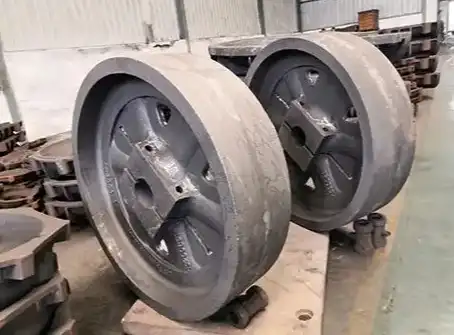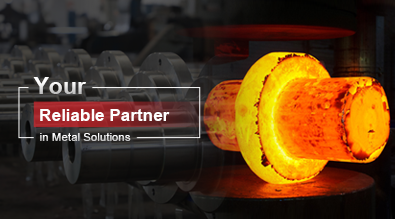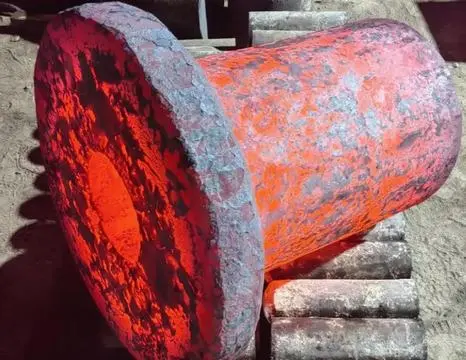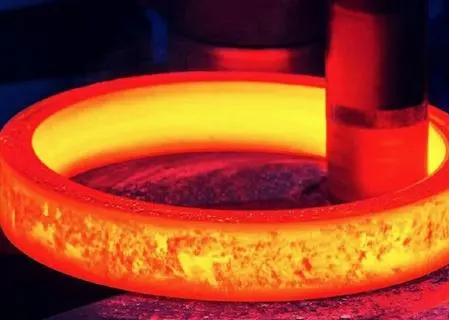What are the unique properties of spheroidal graphite cast iron?
Superior Strength and Ductility
Spheroidal graphite cast iron, also known as ductile iron or nodular iron, possesses exceptional strength and ductility compared to traditional gray cast iron. The spheroidal shape of graphite particles in this material contributes to its improved mechanical properties. Unlike the flake-like graphite structure found in gray cast iron, the spheroidal graphite nodules act as "crack-stoppers," preventing the propagation of cracks under stress. This unique microstructure allows spheroidal graphite cast iron to withstand higher loads and exhibit greater resistance to deformation. The combination of high tensile strength and elongation makes it suitable for applications requiring both strength and toughness, such as automotive components, heavy machinery parts, and structural elements in construction.
Excellent Machinability
Another significant advantage of spheroidal graphite cast iron is its excellent machinability. The presence of graphite nodules in the microstructure acts as a natural lubricant during machining operations, reducing tool wear and improving surface finish. This characteristic makes spheroidal graphite cast iron highly desirable for manufacturers who require precise and cost-effective machining processes. The material's ability to be easily machined allows for the production of complex shapes and intricate designs without compromising structural integrity. Iron casting foundries appreciate this property as it enables them to meet tight tolerances and produce high-quality components with minimal post-casting processing, ultimately reducing production costs and improving overall efficiency.
Versatility in Applications
Spheroidal graphite cast iron's versatility makes it an attractive option for iron casting foundries serving diverse industries. Its unique combination of properties allows it to be used in a wide range of applications, from automotive and aerospace to energy and infrastructure. The material's high strength-to-weight ratio makes it ideal for lightweight yet durable components, while its excellent wear resistance and fatigue strength make it suitable for critical parts subjected to cyclic loading. Additionally, spheroidal graphite cast iron exhibits good thermal conductivity and damping characteristics, making it valuable in applications requiring heat dissipation or vibration reduction. This versatility enables foundries to cater to various customer needs and expand their product offerings, making spheroidal graphite cast iron a preferred choice for many casting projects.
How does spheroidal graphite cast iron compare to other iron alloys?
Improved Mechanical Properties
When comparing spheroidal graphite cast iron to other iron alloys, its improved mechanical properties stand out significantly. Unlike gray cast iron, which tends to be brittle due to its flake graphite structure, spheroidal graphite cast iron offers a remarkable combination of strength and ductility. This makes it superior to gray iron in applications where impact resistance and fatigue strength are crucial. Compared to malleable iron, spheroidal graphite cast iron exhibits higher tensile strength and yield strength, often surpassing even some grades of steel. The unique graphite nodules in spheroidal graphite cast iron contribute to its ability to withstand higher stresses and strains without failure, making it an excellent choice for components subjected to dynamic loading. Iron casting foundries value these enhanced mechanical properties as they allow for the production of lighter, stronger, and more reliable parts across various industries.
Cost-Effectiveness
Spheroidal graphite cast iron offers a cost-effective solution compared to many other iron alloys and even some grades of steel. While the initial material cost may be slightly higher than that of gray iron, the overall production costs are often lower due to several factors. Firstly, the superior mechanical properties of spheroidal graphite cast iron allow for thinner wall sections and lighter designs, reducing material usage and associated costs. Secondly, its excellent machinability leads to reduced tooling wear and faster machining times, resulting in lower production expenses. Additionally, the versatility of spheroidal graphite cast iron enables foundries to produce complex shapes with fewer secondary operations, further reducing manufacturing costs. When compared to forged steel or welded fabrications, spheroidal graphite cast iron components can often be produced more economically, especially for intricate designs or large production volumes. This cost-effectiveness makes spheroidal graphite cast iron an attractive option for iron casting foundries looking to optimize their production processes and offer competitive pricing to their customers.
Environmental Considerations
In today's environmentally conscious world, spheroidal graphite cast iron presents several advantages over other iron alloys from an ecological perspective. The production of spheroidal graphite cast iron typically requires lower melting temperatures compared to steel, resulting in reduced energy consumption and lower carbon emissions during the manufacturing process. Furthermore, the material's excellent recyclability allows for efficient reuse of scrap, minimizing waste and conserving resources. The longevity and durability of spheroidal graphite cast iron components also contribute to sustainability by reducing the need for frequent replacements and minimizing the overall environmental impact throughout the product lifecycle. Iron casting foundries increasingly prioritize environmental considerations, and the use of spheroidal graphite cast iron aligns well with their sustainability goals. By choosing this material, foundries can demonstrate their commitment to eco-friendly practices while still delivering high-quality, reliable products to their customers.
What are the challenges in working with spheroidal graphite cast iron?
Precise Process Control
Working with spheroidal graphite cast iron presents unique challenges, particularly in terms of precise process control. The production of high-quality spheroidal graphite cast iron requires careful management of various parameters throughout the casting process. One of the critical aspects is the inoculation and nodularization treatment, which involves adding specific elements to the molten iron to promote the formation of spheroidal graphite. This process demands strict control over timing, temperature, and composition to achieve the desired microstructure. Any deviations in these parameters can lead to the formation of non-spheroidal graphite, compromising the material's properties. Additionally, the cooling rate during solidification plays a crucial role in determining the final microstructure and mechanical properties of the casting. Iron casting foundries must invest in advanced process control systems and skilled personnel to maintain consistent quality in spheroidal graphite cast iron production. Despite these challenges, the benefits of working with this material often outweigh the complexities, driving foundries to continuously improve their processes and expertise in handling spheroidal graphite cast iron.
Material Shrinkage
Another challenge associated with spheroidal graphite cast iron is managing material shrinkage during the casting process. Like most metals, spheroidal graphite cast iron undergoes volumetric contraction as it solidifies and cools. However, the extent of shrinkage in this material can be more pronounced compared to some other iron alloys. This characteristic requires careful consideration in mold design and gating systems to ensure proper feeding of molten metal during solidification. Failure to address shrinkage adequately can result in defects such as shrinkage porosity or internal voids, which can significantly impact the mechanical properties and integrity of the final casting. To overcome this challenge, iron casting foundries must employ advanced simulation software and leverage their expertise to optimize mold designs, implement effective risering techniques, and fine-tune process parameters. While managing shrinkage adds complexity to the casting process, it is a necessary step in producing high-quality spheroidal graphite cast iron components that meet stringent performance requirements across various applications.
Heat Treatment Considerations
Heat treatment of spheroidal graphite cast iron presents both opportunities and challenges for iron casting foundries. On one hand, heat treatment processes such as annealing, normalizing, or austemperingcan significantly enhance the material's properties, tailoring them to specific application requirements. For instance, austempering can produce a microstructure known as austempered ductile iron (ADI), which exhibits exceptional strength and wear resistance. However, the heat treatment of spheroidal graphite cast iron requires precise control of temperature, time, and cooling rates to achieve the desired results. Improper heat treatment can lead to undesirable microstructural changes, such as the formation of carbides or the degradation of graphite nodules, which can negatively impact the material's performance. Additionally, the size and geometry of the casting can affect heat treatment uniformity, requiring careful consideration of furnace loading and quenching techniques. Despite these challenges, many iron casting foundries invest in heat treatment capabilities to offer value-added services and expand their product range. By mastering the intricacies of heat treating spheroidal graphite cast iron, foundries can provide customers with optimized components that meet specific performance criteria across a wide range of applications.
Conclusion
Spheroidal graphite cast iron has become a preferred choice for iron casting foundries due to its exceptional combination of strength, ductility, and versatility. Its unique properties, cost-effectiveness, and environmental benefits make it an attractive option for various industries. While working with this material presents challenges in process control, shrinkage management, and heat treatment, the advantages it offers often outweigh these complexities. As technology advances and foundries continue to refine their expertise, spheroidal graphite cast iron is likely to remain a crucial material in the iron casting industry, enabling the production of high-performance components for years to come.
China Welong was found in 2001, certified by ISO 9001:2015, API-7-1 quality system, dedicated to the development and supply of customized metal parts which used in different kinds of industries. Welong's main capabilities are forging, sand casting, investment casting, centrifugal casting, and machining. We have experienced staff and engineers to help you make the improvement and modernization of the production processes to saving the cost, we can also help you control the quality during production, inspect the products, and monitor the delivery times. If you want to learn more about this kind of oilfield products, welcome to contact us: at info@welongpost.com.




